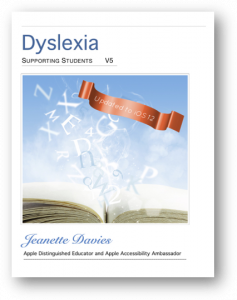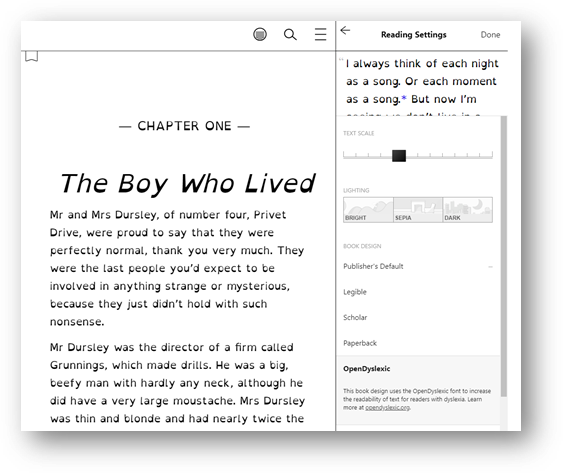
The importance of inclusive education
By: Hannah Monson, Content Specialist
October is National Dyslexia Awareness Month here in the United States, as well as in Australia. October is also recognized as ADHD Awareness month in many countries across the globe, including the United States, Australia, Canada and the United Kingdom.
 Because of the international spotlight on special education in October, I reached out to Jeanette Davies, an OverDrive partner in Australia who’s an expert in what’s known throughout that country as “inclusive education.”
Because of the international spotlight on special education in October, I reached out to Jeanette Davies, an OverDrive partner in Australia who’s an expert in what’s known throughout that country as “inclusive education.”
Jeanette is part of a task force of world leaders focused on accessibility technology and has been recognized as an Apple Distinguished Educator and Apple Accessibility Ambassador. She works in library management and inclusive technology at the Catholic Education Office, Wollongong, in New South Wales, Australia. Jeanette is also the author of iPad Tips & Tricks: With a Focus on Accessibility, Dyslexia: Supporting Students and Accessibility at Home (co-written with Christopher Hills, Michael Harrison, Greg Alchin and David Woodbridge). She has been an OverDrive partner for six years.
As an expert in the field, Jeanette was kind enough to answer my questions and provide some insights about special/inclusive education.
What is the evolution of special/inclusive education in Australia?
Although we still have specialist schools, students with disabilities are now supported in our mainstream schools. This has led to the development of specialist services. For example, in our Diocese, we have a team at our head office where we have people who specialise in particular areas, like vision support, hearing support, etc. My role is to source technology solutions for students who present with a disability. This allows the mainstream teacher direct access to specialist support when a student arrives in their classroom who requires additional help.
Where does digital reading fit in the inclusive education spectrum?
Print disability is probably the largest area we deal with, as it not only means supporting students with low vision but students who can’t physically hold a book and turn the pages and also students who have difficulties reading due to dyslexia or intellectual impairments. Audiobooks fit in nicely here, of course; however, for physical impairments, using a switch is the answer. In this scenario, the student can access both ebooks and audiobooks. The ability to personalise the text in ebooks can never be underestimated. Whenever I show students (the Sora reading app), I always include personalising the text, as this truly is inclusive, improving the reading experience for all.
Do you have any stories about how Sora has changed a students’ reading experience?
Oh, I have many! My biggest challenge is to find required reading texts for secondary students, in particular, (for) their final year exams where they study a text for a year or more. We had only just started setting up OverDrive when I received the dreaded (question), “Do you have The Story of Tom Brennan in audio?” I doubted OverDrive would have it, but tried anyway, and you did! Better still, I was able to use (the Title Assignment feature) so the student could have it until after his exam. Teacher, student and I were delighted! Moving forward six years, we have been able to help so many students!
Being able to create collections like our “Primary Easy Reads” and “YA Easy Reads” means teachers know it really means “high interest, low text difficulty.” Other students in the classroom can’t see the book cover, so the added benefit is that it is also discreet. As stated above, being able to personalise the text has a huge impact on our students. Following the basics of readability, this benefits ALL students and fits nicely in the statement “clearing a path for students with a disability, clears the path for all.” Whenever I simply show changing the font from default to Sans Serif, the whole class will express their delight as to how much easier it is to read the text.
What can American educators learn from the way Australia works with students under the inclusive education umbrella?
Well, I’m unsure how it is in America, and I can only speak from my own experience. Inclusion is high priority, and we work hard to achieve this. For students with a disability in our mainstream schools, it is important that the classroom teacher is able to have a point of contact for specialist help when required. Also, in our Diocese, we have in recent years created a classroom onsite in some primary schools for students with autism. The goal here is that they will transition to the mainstream school. At the end of the day, the goal is total inclusion.
As a company, we’re always trying to be mindful of representation and diversity. Can you recommend some books featuring unique characters that all educators should add to their curriculum?
I like this website that collates books featuring characters who are blind or visually impaired, and the same for students who are deaf. I also recommend Disability in KidLit for general literature featuring characters with a disability.
If you’d like to add titles featuring special needs characters to your collection, check out the lists below, or reach out to your OverDrive Content Specialist for carts!
- Blind/Visually Impaired Characters
- Deaf/Hearing Impaired Characters and Authors
- Disability in KidLit Books Reviews (all titles on this list have been reviewed by Disability in KidLit and have reviews here)
Browse blog and media articles
Public Library Training
K-12 Library Training
